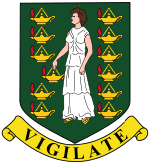Saint Ursula
Edwin Pierson
- This article is about the saint. For schools by the same name, see St. Ursula Academy.
| Saint Ursula | |
|---|---|
| Virgin and Martyr | |
| Died | A.D. 383 |
| Major shrine | Cologne |
| Feast | October 21 |
| Attributes | Eleven thousand companions, banner, cloak |
| Patronage | Cologne, Delphi, England, archers, orphans, students |
| Catholic cult suppressed | 1969 |
Ursula ("small female bear" in Latin) is a British Christian saint. Her feast day in the Roman Catholic Church is October 21, though her feast was removed from the general calendar of saints in 1969.
Her legend, probably unhistorical, is that she was a Romano-British princess who, at the request of her father King Donaut of Dumnonia in south-west England, set sail to join her future husband, the pagan Governor Conan Meriadoc of Armorica (Brittany), along with 11,000 virginal handmaidens. However, a miraculous storm brought them over the sea in a single day to a Gaulish port, where Ursula declared that before her marriage she would undertake a pan-European pilgrimage. She headed for Rome, with her followers, and persuaded the Pope, Cyriacus (unknown in the pontifical records), and Sulpicius, Bishop of Ravenna, to join them. After setting out for Cologne, which was being besieged by Huns, all the virgins were beheaded in a dreadful massacre. The Huns' leader shot Ursula dead, supposedly in 383.
Ursula and her fellow virgins were buried in Cologne where the Church of St. Ursula is dedicated to her. The Order of Ursulines, founded in 1535 by Angela Merici, and especially devoted to the education of young girls, has also helped to spread throughout the world the name and the cult of St. Ursula. St. Ursula was named the patron saint of students.
While there was a tradition of virgin martyrs in Cologne by the 5th century, this was limited to a small number between two and eleven according to different sources. The 11,000 were first mentioned in the 9th century; suggestions as to where this came from have included reading the name "Undecimillia" or "Ximillia" as a number, or reading the abbreviation "XI. M. V." as eleven thousand (in Roman numerals) virgins rather than eleven martyred virgins. Another theory however is that the number 11,000 originated in the middle ages, when bones of dubious origin were being sold as relics of Martyrs. St. Ursula and her virgins were very popular, and according to the (rather cynical) theory, people sold so many bones of the Saint and the virgins that people invented the 11,000 virgins as an explanation for the ample supply of bones (which in fact were the remains of people buried in a churchyard dating back to Roman times).

Today the story of Saint Ursula is overwhelmingly considered to be fiction, and as a result in 1969 Pope Paul VI suppressed her cult as part of a larger revision of the Catholic canon of saints.
Christopher Columbus named the Virgin Islands after her and her virgins. On 21 October 1521, Ferdinand Magellan rounded Cape Virgenes and entered the Straits of Magellan, naming the cape after Ursula's virgins. Portuguese explorer João Álvares Fagundes in 1521 named 'Eleven Thousand Virgins' what is now known as Saint-Pierre and Miquelon.
Interesting facts
- The name "Ursula" means "Little she-bear" (diminutive of Latin "ursa").
- Hildegard of Bingen composed many chants in honour of virgins. An entire album of songs for St Ursula has been issued on CD by the a cappella group Anonymous 4: 11,000 Virgins: Chants for the Feast of St. Ursula, Harmonia Mundi, 1997
- The street in London called St Mary Axe is sometimes said to be derived from a church, now demolished, dedicated to St Mary the Virgin, St Ursula and the 11,000 Virgins. It was said to located where the skyscraper informally known as "the Gherkin" is now located. The church contained a holy relic: an axe used by the Huns to execute the virgins. However, this legend cannot be dated any earlier than 1514.[1]
- Ursula K. Le Guin, the noted science fiction writer, was born on October 21, 1929, in Berkeley, California and named for St. Ursula.
See also
- Ursula Julia Ledochowska (Canonised 2005)
Notes
External links
- Patron Saints: Ursula
- Early British Kingdoms: St. Ursula
- 'The life of St Ursula and the 11,000 Virgins' in the Lady Lever Art Gallery
- Catholic Encyclopedia
- The Saints of Cornwall
Credits
New World Encyclopedia writers and editors rewrote and completed the Wikipedia article in accordance with New World Encyclopedia standards. This article abides by terms of the Creative Commons CC-by-sa 3.0 License (CC-by-sa), which may be used and disseminated with proper attribution. Credit is due under the terms of this license that can reference both the New World Encyclopedia contributors and the selfless volunteer contributors of the Wikimedia Foundation. To cite this article click here for a list of acceptable citing formats.The history of earlier contributions by wikipedians is accessible to researchers here:
The history of this article since it was imported to New World Encyclopedia:
Note: Some restrictions may apply to use of individual images which are separately licensed.
